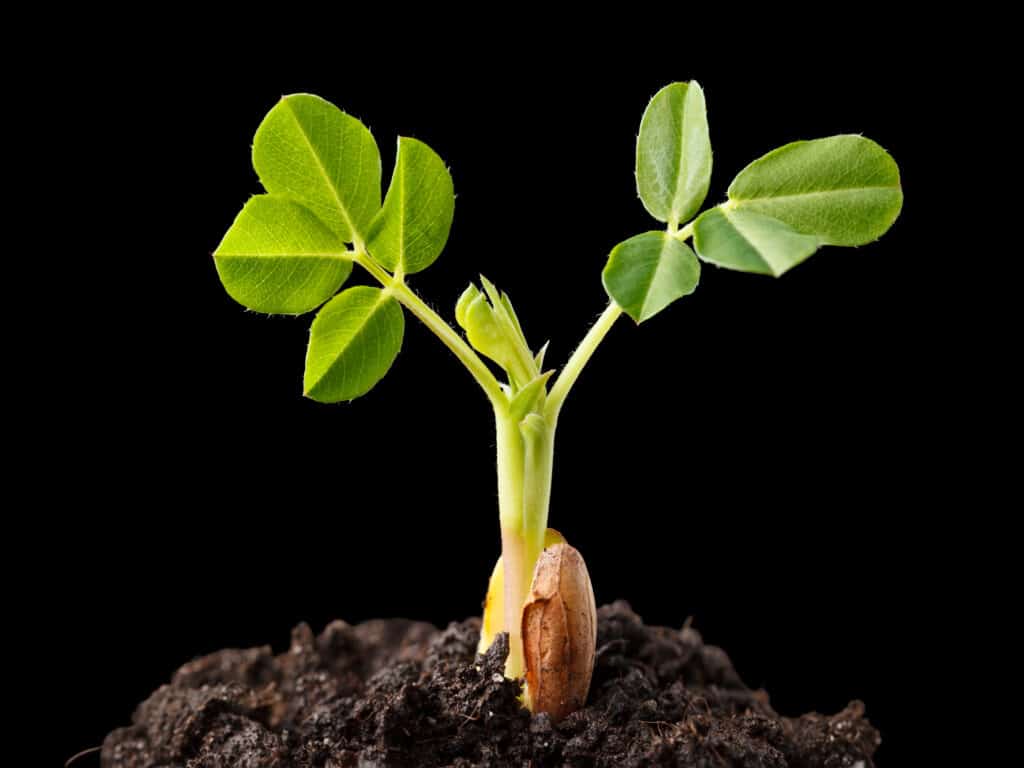 18اردیبهشت
18اردیبهشت
Sustainable and Versatile: The Peanut's Promise

Sustainable and Versatile: The Peanut's Promise
Peanuts offer a compelling proposition for the future of agriculture. This legume, with its South American origins, boasts a remarkable capacity to enrich soil health, deliver exceptional nutritional value, and contribute significantly to the economic landscape. From South Carolina's fertile fields to the rich farmlands of Texas and Georgia, peanuts have become a cornerstone crop across diverse regions.
One key factor in the peanut's sustainability lies in its unique growth cycle. The fascinating process of pegging, where flowers self-pollinate underground and develop into pods, minimizes environmental impact. Furthermore, peanuts are a model of resource efficiency, with every part of the plant, from roots to hulls, finding valuable use.
The environmental benefits of peanut cultivation are undeniable. Compared to other nuts, peanuts require less water and boast a demonstrably smaller carbon footprint. This makes them an attractive and sustainable option for farmers. Beyond their low impact, peanuts play a vital role in enhancing soil fertility. Their ability to fix nitrogen in the soil translates to improved overall crop health through crop rotation strategies.
Integrating peanuts into crop rotation plans offers a multitude of advantages. Such practices help manage pests and diseases, promote overall crop health, and contribute to a more balanced nutritional profile within the soil. The nitrogen-fixing properties of peanuts also reduce reliance on fertilizers, lowering agricultural inputs and associated greenhouse gas emissions. Studies indicate that rotating peanuts with crops like cotton and corn can significantly improve soil health and disease resistance. For optimal peanut growth and yield, well-drained, light-colored, loose soils with a pH between 5.8 and 6.5 are recommended.

Peanuts: Powerhouse of Nutrition and Economic Engine
The significance of peanuts goes far beyond their sustainable farming practices. These legumes offer a treasure trove of nutritional benefits and significant economic clout. Peanuts are a champion source of plant-based protein, healthy fats, and fiber. They're also brimming with essential nutrients like biotin, copper, niacin, and manganese. This nutritional profile makes them a perfect addition to healthy and sustainable diets. Furthermore, peanuts' versatility extends to their numerous processed forms – peanut butter, oil, flour, and a variety of snacks. This variety fuels both healthy eating habits and economic growth.
The U.S. peanut industry stands as a testament to this economic contribution. Ranking as the seventh most valuable crop in the nation, with a farm value exceeding $1 billion, peanuts are a powerhouse for the agricultural sector.

A Sustainable Legacy
In essence, the sustainability of peanuts is a multifaceted story. It starts with their contribution to soil health and minimal environmental impact, and blossoms into their undeniable nutritional benefits. From cultivation practices to diverse applications, peanuts embody the core principles of sustainable agriculture. They promote healthier farming methods, enrich diets with vital nutrients, and foster economic stability for farming communities. For these reasons, peanuts remain a crop of immense significance, impacting both local and global landscapes. As we move forward, peanuts undoubtedly hold the promise of a more sustainable and prosperous agricultural future.
Growing and Caring for Peanuts
Planting Peanuts
- Peanuts should be planted after the last frost, typically in April through May, when soil temperatures reach 65-70°F (18-21C°).
- Plant peanut seeds 1-2 inches deep, 4-6 inches apart, with 3 feet between rows.
- Sow the seeds directly outdoors and keep the soil moist to ensure germination, which takes 10-15 days.
- Thin the seedlings to 8-12 inches apart when they reach about 2 inches tall.
- As the plants grow to about 1 foot tall, "hill" them by adding soil around the stem base and apply a light mulch to control weeds. This helps accommodate the peanut pegs.

Watering Peanuts
- Peanuts need about 1 inch of water per week, from rainfall or irrigation, during the growing season.
- Watering is most critical:
- At planting, to ensure germination and seedling establishment.
- 60-110 days after planting, when the pegs have entered the soil and pods are developing.
- Avoid wetting the leaves and use drip irrigation if possible. The soil should be moist but not saturated.
- Stop watering 10-14 days before harvesting.
Soil and Nutrition
- Peanuts prefer loose, well-drained, sandy loam soil with a slightly acidic pH of 6.0-6.5. Avoid heavy clay soils.
- Peanuts are legumes that fix their own nitrogen if Rhizobium bacteria are present. However, it's recommended to inoculate the seeds at planting if planting in an area without recent peanut cultivation.
- Provide calcium in the top 6 inches of soil, as peanuts have high calcium requirements for pod development. Bone meal or gypsum can be added at planting.
- Peanuts are sensitive to fertilizer burn, so apply any fertilizer before planting and thoroughly mix it into the soil.

Harvesting and Curing
- Peanuts are ready to harvest in late summer or early fall, typically 140-150 days after planting.
- Harvest signs include yellowed foliage and mature pods with darkened, veined shells and colored seed coats.
- Dig or pull up the entire plant when the soil is dry, gently shake off excess soil.
- Hang the plants with attached pods in a warm, dry location with good air circulation to cure for about 1 week.
- After curing, remove the pods from the vines and continue air-drying the peanuts for 1-2 more weeks.
Pests and Diseases
- Common pests include squirrels, mice, armyworms, and caterpillars. Diseases include leaf spot, rust, blight, and viral diseases.
- Consult your local university extension office for identification and control recommendations.
By following these guidelines for planting, watering, soil preparation, and harvesting, you can successfully grow a bountiful peanut crop in your home garden. Remember to source your peanut seeds from a reputable supplier for the best results.
References
- 1- The Peanut Institute. (n.d.). Peanuts and the Environment. Retrieved from https://www.peanut-institute.org/peanut-power/peanuts-and-the-environment/
- 2- American Peanut Council. (2021). Sustainability Report. Retrieved from https://www.peanutsusa.com/sustainability-report.html
- 3- (2021). Crop Values 2020 Summary. Retrieved from https://www.nass.usda.gov/Publications/Todays_Reports/reports/cpvl0221.pdf
- 4- Cotton Incorporated. (2020). Cotton, Peanut Rotation Provides Value to Both Crops. Retrieved from https://www.cottoninc.com/cotton-production/agronomics/crop-rotation/cotton-peanut-rotation/
- 5- Peanut Institute. (n.d.). Peanuts are The Crop of Now: The Future of Sustainable Farming. Retrieved from https://www.peanut-institute.org/peanut-power/peanuts-are-the-crop-of-now/
- 6- The Peanut Institute. (n.d.). 3 Fast Facts About Peanuts and Sustainability. Retrieved from https://www.peanut-institute.org/peanut-power/3-fast-facts-about-peanuts-and-sustainability/
- 7- National Peanut Board. (2022). Peanut power: How the little legume plays a big role for sustainability. Retrieved from https://www.nationalpeanutboard.org/news/peanut-power-how-the-little-legume-plays-a-big-role-for-sustainability.htm
- 8- Cotton Incorporated. (2020). Cotton, Peanut Rotation Provides Value to Both Crops. Retrieved from https://www.cottoninc.com/cotton-production/agronomics/crop-rotation/cotton-peanut-rotation/
- 9- Clemson University. (2019). Management and Cultural Practices for Peanuts. Retrieved from https://hgic.clemson.edu/factsheet/management-and-cultural-practices-for-peanuts/
- 10- University of Georgia Extension. (2018). Peanut Production Guide. Retrieved from https://extension.uga.edu/publications/detail.html?number=B1127&title=Peanut%20Production%20Guide
- 11- Texas A&M AgriLife Extension. (2022). Peanut Harvest and Curing. Retrieved from https://aggie-horticulture.tamu.edu/vegetable/guides/peanut-production/peanut-harvest-and-curing/
- 12- North Carolina State University Extension. (2020). Peanut Irrigation Management. Retrieved from https://peanuts.ces.ncsu.edu/peanut-irrigation-management/
- 13- Virginia Cooperative Extension. (2009). Peanut Production Guide. Retrieved from https://www.pubs.ext.vt.edu/content/dam/pubs_ext_vt_edu/2906/2906-1393/2906-1393_pdf.pdf
- 14- Alabama Cooperative Extension System. (2021). Peanut Production. Retrieved from https://www.aces.edu/blog/topics/crop-production/peanut-production/
- 15- University of Florida IFAS Extension. (2022). Inoculating Peanut Seed. Retrieved from https://edis.ifas.ufl.edu/publication/AG169
- 16- University of Georgia Extension. (2020). Calcium and Peanuts. Retrieved from https://extension.uga.edu/publications/detail.html?number=C1087&title=Calcium%20and%20Peanuts
- 17- Clemson Cooperative Extension. (2021). Calcium for Peanuts. Retrieved from https://hgic.clemson.edu/factsheet/calcium-for-peanuts/
- 18- Virginia Cooperative Extension. (2009). Peanut Production Guide. Retrieved from https://www.pubs.ext.vt.edu/content/dam/pubs_ext_vt_edu/2906/2906-1393/2906-1393_pdf.pdf
- 19- Texas A&M AgriLife Extension. (2022). Peanut Harvest and Curing. Retrieved from https://aggie-horticulture.tamu.edu/vegetable/guides/peanut-production/peanut-harvest-and-curing/
- 20- University of Georgia Extension. (2018). Peanut Production Guide. Retrieved from https://extension.uga.edu/publications/detail.html?number=B1127&title=Peanut%20Production%20Guide
- 21- University of Georgia Extension. (2018). Peanut Production Guide. Retrieved from https://extension.uga.edu/publications/detail.html?number=B1127&title=Peanut%20Production%20Guide
- 22- Texas A&M AgriLife Extension. (2022). Peanut Harvest and Curing. Retrieved from https://aggie-horticulture.tamu.edu/vegetable/guides/peanut-production/peanut-harvest-and-curing/
- 23- University of Georgia Extension. (2018). Peanut Production Guide. Retrieved from https://extension.uga.edu/publications/detail.html?number=B1127&title=Peanut%20Production%20Guide
- 24- Texas A&M AgriLife Extension. (2022). Peanut Harvest and Curing. Retrieved from https://aggie-horticulture.tamu.edu/vegetable/guides/peanut-production/peanut-harvest-and-curing/
- 25- Virginia Cooperative Extension. (2009). Peanut Production Guide. Retrieved from https://www.pubs.ext.vt.edu/content/dam/pubs_ext_vt_edu/2906/2906-1393/2906-1393_pdf.pdf
- 26- Clemson Cooperative Extension. (2021). Peanut Insect Pests and Diseases. Retrieved from https://hgic.clemson.edu/factsheet/peanut-insect-pests-and-diseases/
- 27- University of Georgia Extension. (2018). Peanut Production Guide. Retrieved from https://extension.uga.edu/publications/detail.html?number=B1127&title=Peanut%20Production%20Guide
- 28- Alabama Cooperative Extension System. (2021). Peanut Production. Retrieved from https://www.aces.edu/blog/topics/crop-production/peanut-production/
- 29- Virginia Cooperative Extension. (2009). Peanut Production Guide. Retrieved from https://www.pubs.ext.vt.edu/content/dam/pubs_ext_vt_edu/2906/2906-1393/2906-1393_pdf.pdf
- 30- University of Georgia Extension. (2018). Peanut Production Guide. Retrieved from https://extension.uga.edu/publications/detail.html?number=B1127&title=Peanut%20Production%20Guide
- 31- Clemson Cooperative Extension. (2021). Peanut Production. Retrieved from https://hgic.clemson.edu/factsheet/peanut-production/
- 32- Texas A&M AgriLife Extension. (2022). Peanut Production Guide. Retrieved from https://aggie-horticulture.tamu.edu/vegetable/guides/peanut-production/
- 33- Virginia Cooperative Extension. (2009). Peanut Production Guide. Retrieved from https://www.pubs.ext.vt.edu/content/dam/pubs_ext_vt_edu/2906/2906-1393/2906-1393_pdf.pdf
- 34- University of Georgia Extension. (2018). Peanut Production Guide. Retrieved from https://extension.uga.edu/publications/detail.html?number=B1127&title=Peanut%20Production%20Guide
- 35- University of Georgia Extension. (2018). Peanut Production Guide. Retrieved from https://extension.uga.edu/publications/detail.html?number=B1127&title=Peanut%20Production%20Guide











